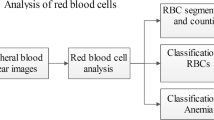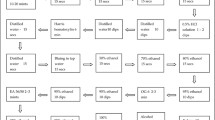Abstract
Cervical Cancer is one of the most pandemic causes of cancer related death in females. Pap smear test is one of the most commonly used screening test for the cervical cancer. Existing algorithms focus on the segmentation of nucleus and cytoplasm either using single-cell images or multiple cells images. Images captured from the Pap smear slides are called smear images. Smear image contains cervical cells along with debris, debris are inflammatory cells, red blood cells, dye. Debris significantly influence the outcome of image segmentation. An accurate nuclei segmentation method can improve the success rate of cervical cancer screening. Therefore, this paper reveals about three segmentation techniques which are used for automated segmentation of cervical cell nuclei in the presence of debris. Three segmentation techniques namely, Automated Seed Region Growing, Extended Edge Based Detection and Modified Moving k-means techniques are proposed to extract the cervical cell nuclei. These techniques are extracting the area of nuclei from smear images using the morphological property of nucleus. Some debris have area that corresponds with the area of nucleus of normal cells, it may interfere with outcome and may give false positive results. The empirical area threshold value demonstrate the superior performance of all proposed methods. The qualitative and quantitative analysis also done on proposed techniques. Experimental analysis shows that Modified Moving k-means give favorable result in dysplasia detection in the presence of debris. A new dataset PapsmearJP is collected during the study with the help of a pathologist for the validation of the work.













Similar content being viewed by others
References
Adams R., Bischof L (1994) Seeded region growing. IEEE Trans Pattern Anal Mach Intell 16(6):641–647
Al-amri SS, Kalyankar NV, Khamitkar SD (2010) Image segmentation by using threshold techniques. J Comput 2(5)
Alias MF, Isa NAM, Sulaiman SA, Mohamed M (2012) Modified moving k-means clustering algorithm. International Journal of Knowledge-based and Intelligent Engineering Systems 16(2):79–86
Arya M, Mittal N, Singh G (2018) Texture-based feature extraction of smear images for the detection of cervical cancer. IET Comput Vis 12(8):1049–1059
Banavali SD (2015) Delivery of cancer care in rural India: experiences of establishing a rural comprehensive cancer care facility. Indian Journal of Medical and Paediatric Oncology: Official Journal of Indian Society of Medical & Paediatric Oncology 36(2):128
Bora K, Chowdhury M, Mahanta LB, Kundu MK, Das AK (2017) Automated classification of Pap smear images to detect cervical dysplasia. Comput Meth Programs Biomed 138:31–47
Canny J (1986) A computational approach to edge detection. IEEE Trans Pattern Anal Machine Intell 8(6):679–698
Chankong T, Theera-Umpon N, Auephanwiriyakul S (2014) Automatic cervical cell segmentation and classification in Pap smears. Comput Meth Programs Biomed 113(2):539–556
Chen Y-F, Huang P-C, Lin K-C, Lin H-H, Wang L-E, Cheng CC, Chen T-P, Chan Y-K, Chiang JY (2014) Semi-automatic segmentation and classification of pap smear cells. IEEE J Biomed Health Inform 18(1):94–108
Cheng F-H, Hsu N-R (2016) Automated cell nuclei segmentation from microscopic images of cervical smear. In: International conference on applied system innovation (ICASI), pp 1–4
HPV vaccine. https://www.webmd.com/vaccines/adult-hpv-vaccine-guidelines#1. Accessed March 2019
Lu Z, Carneiro G, Bradley AP (2013) Automated nucleus and cytoplasm segmentation of overlapping cervical cells. In: 452–460
Martin, Pap-smear (DTU/Herlev) Databases and Related Studies. http://mde-lab.aegean.gr/index.php/. Accessed April 2003
Mashor MY (2000) Hybrid training algorithm for RBF network. International Journal of the Computer the Internet and Management 8(2):50–65
Mbaga AH, Zhijun P (2015) Pap smear images classification for early detection of cervical cancer. Int J Comput Appl 118(7)
Melouah AHLEM, Amirouche RADIA (2014) Comparative study of automatic seed selection methods for medical image segmentation by region growing technique. Recent Advances in Biology, Biomedicine and Bioengineering, pp 91–97
Mithlesh A, Mittal N, Singh G (2019) Cervical cancer detection using single cell and multiple cell histopathology images. In: International conference on emerging technologies in computer engineering. Springer, Singapore, pp 205–215
Otsu N (1979) A threshold selection method from gray-level histograms. IEEE Trans Sys Man Cybern 9(1):62–66
Paul PR, Bhowmik MK, Bhattacharjee D (2015) Automated cervical cancer detection using pap smear images. In: Proceedings of fourth international conference on soft computing for problem solving, pp 267–278
Plissiti ME, Nikou C, Charchanti A (2011) Automated detection of cell nuclei in Pap smear images using morphological reconstruction and clustering. IEEE Trans Inf Technol Biomed 15(2):233–241
Sajeena TA, Jereesh AS (2015) Automated cervical cancer detection through RGVF segmentation and SVM classification. In: International conference on computing and network communications (CoCoNet), pp 663–669
Senthilkumaran N, Rajesh R (2009) Edge detection techniques for image segmentation-a survey of soft computing approaches. Int J Recent Trends Eng 1(2):250
Shih FY, Cheng S (2005) Automatic seeded region growing for color image segmentation. Image Vis Comput 23(10):877–886
Srivastava AN, Misra JS, Srivastava S, Das BC, Gupta S (2018) Cervical cancer screening in rural India: status & current concepts. The Indian Journal of Medical Research 148(6):687
Tan SY, Tatsumura Y (2015) George Papanicolaou (1883–1962): discoverer of the Pap smear. Singapore Medical Journal 56(10):586
What is cervical cancer. https://www.medicalnewstoday.com/articles/159821.php. Accessed Jan 2019
William W, Ware A, Basaza-Ejiri AH, Obungoloch J (2019) Cervical cancer classification from Pap-smears using an enhanced fuzzy C-means algorithm. Informatics in Medicine Unlocked 14:23–33
William W, Ware A, Basaza-Ejiri AH, Obungoloch J (2019) A pap-smear analysis tool (PAT) for detection of cervical cancer from pap-smear images. Biomedical Engineering Online 18(1):16
Zhang YJ (1996) A survey on evaluation methods for image segmentation. Pattern Recogn 29(8):1335–1346
Zhao J, Li Q, Li X, Li H, Li Z (2019) Automated segmentation of cervical nuclei in pap smear images using deformable multi-path ensemble model. IEEE 16th International Symposium on Biomedical Imaging, pp 1514–1518
Acknowledgements
We would like to thank Dr.Archana Parikh (Cytologist) for providing us Pap smear slides from their pathology lab ‘Parikh Pathology Center’, Jaipur with findings. We are also thankful to Dr.Mukesh Rathore (MBBS, MD) for helping us in capturing the smear images using the microscope. We are also grateful to Mr.Saksham Agarwal for help.
Author information
Authors and Affiliations
Corresponding author
Additional information
Publisher’s note
Springer Nature remains neutral with regard to jurisdictional claims in published maps and institutional affiliations.
Rights and permissions
About this article
Cite this article
Arya, M., Mittal, N. & Singh, G. Three segmentation techniques to predict the dysplasia in cervical cells in the presence of debris. Multimed Tools Appl 79, 24157–24172 (2020). https://doi.org/10.1007/s11042-020-09206-9
Received:
Revised:
Accepted:
Published:
Issue Date:
DOI: https://doi.org/10.1007/s11042-020-09206-9




